Normandy is one of the most beautiful and diverse regions in France. It is home to dramatic chalk cliffs, stunning sandy beaches, medieval towns and the iconic Mont Saint-Michel. It’s also a region rich in history, from William the Conqueror’s 1066 invasion to the D-Day landings of World War II. Yet it’s the peaceful villages and elegant seaside towns that make you slow down and stay a little longer.
It’s also surprisingly easy to get to Normandy from the UK; you can take a ferry from Portsmouth straight into Normandy, or hop on the Eurotunnel and drive. It even works as a long weekend.
We’ve actually been to Normandy a couple of times before; once we even cycled around Normandy all the way from the UK, and if you want to see that adventure, you can check out the series on my YouTube channel.
In this guide, I’m sharing the most beautiful villages and coastal towns in Normandy, along with tips on when to visit, how to get around, and where to stay.
This post contains affiliate links, and if you click one, I may receive a small commission at no extra cost to you.
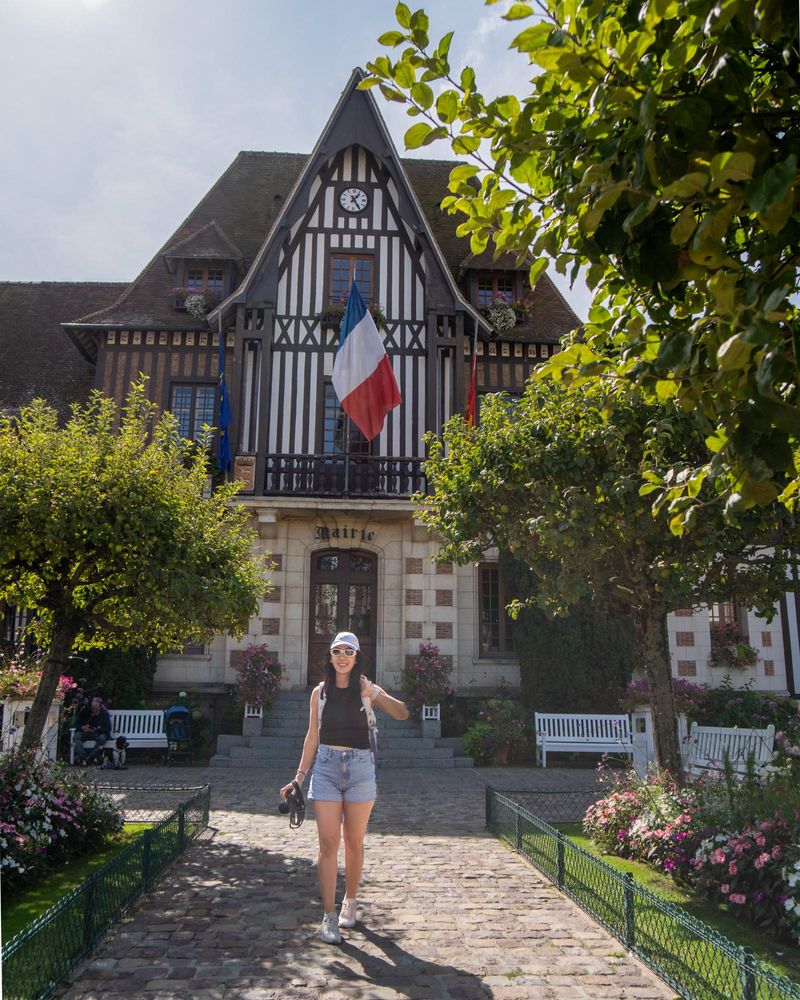
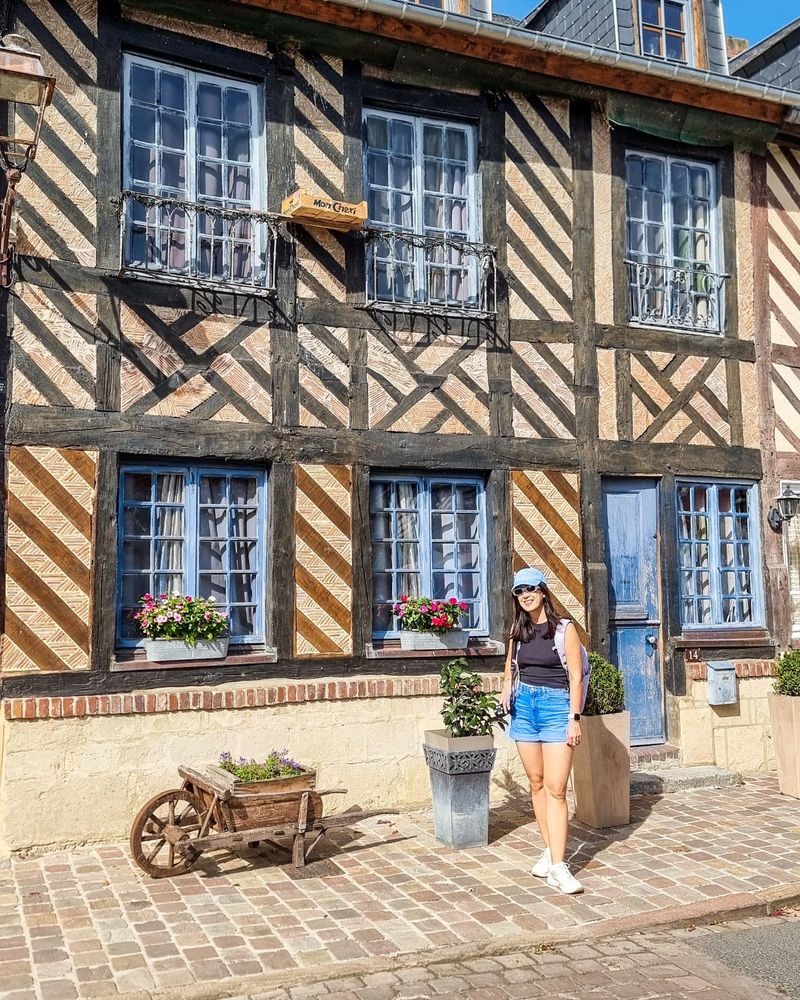
Quick tips for planning your Normandy trip:
How long: A long weekend for highlights; 5–7 days for a relaxed loop.
Best time: Late spring to early autumn for longer days and flowers; July–August is busiest.
Getting around: Driving gives the most freedom along the coast and countryside.
Car hire: Pick up in Caen or Deauville. Compare car hire on Rental Cars or Discover Cars.
Best places to stay: La Ferme Saint-Siméon (Honfleur); Dormy House (Étretat); Villa Lara (Bayeux); Grand Hôtel Cabourg – MGallery (Cabourg); Auberge Saint-Pierre (Mont Saint-Michel, on-island).
Beuvron-en-Auge
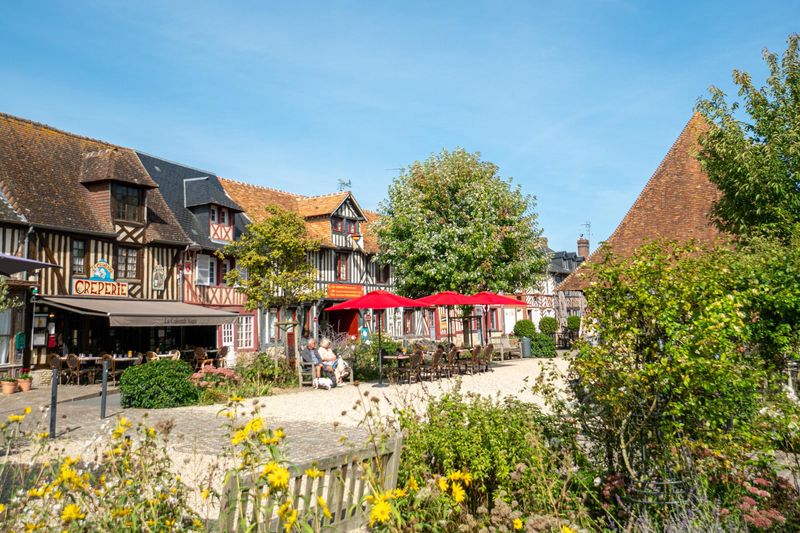
Beuvron-en-Auge is one of the most beautiful villages not only in Normandy but in all of France. This tiny village is like a postcard of Normandy, with cobbled streets, colourful timber-framed houses and a 17th-century covered market at its heart.
Many of the buildings here date from the 16th and 17th centuries, carefully restored to preserve the village’s character. It used to be a market town; today, instead of market traders, you’ll find antique shops, craft boutiques and small cafés where you can try local Norman specialities. The village is part of the Cider Route, a 40-kilometre trail through orchards and villages, where you can stop at farms to taste traditional cider, Calvados and Normandy cheeses. Even if you don’t have time to follow the whole route, Beuvron-en-Auge is the perfect place to experience the cider side of Normandy. If you’re driving, there’s a free, but small, car park on the edge of the village.
If you’d like to stay the night in or near the village, try Le Pavé d’Hôtes, characterful rooms a few steps from the square; warm, personal hospitality, or Aux Trois Damoiselles, an elegant townhouse with rooms overlooking the square and a pretty garden.
Honfleur
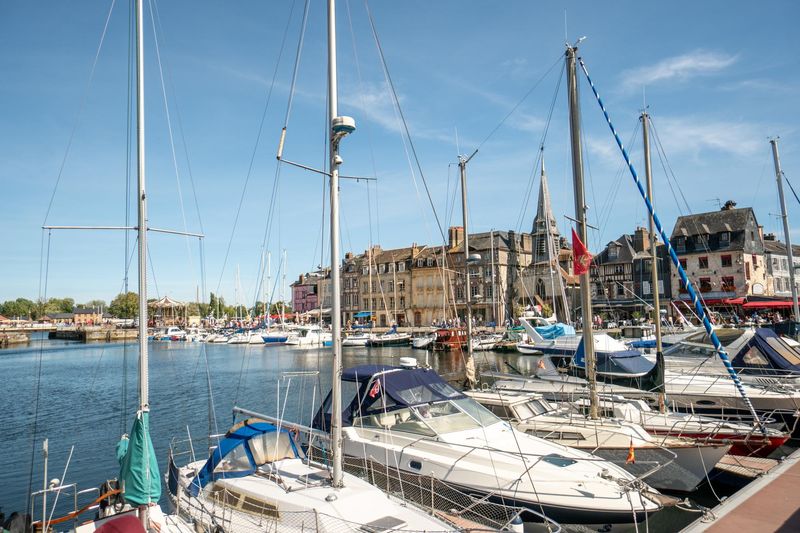
Honfleur is one of the most popular and prettiest places in Normandy. We first visited on our bikepacking trip, fell in love with it, and that’s why we keep coming back. The old harbour looks like a painting, and in the 19th century it became an artistic hub, attracting painters, musicians and writers. You can still feel that creative energy today in the many galleries and studios scattered around town. Don’t miss the largest wooden church in France, built by shipbuilders in the 15th century; it’s a beautiful reminder of Honfleur’s maritime past.
The best way to enjoy Honfleur is to slow down: wander the cobbled streets, browse the antique shops and galleries, and settle in for seafood. Mussels and oysters are local favourites. If you can, stay overnight; once the day-trippers leave, the harbour is calmer and the golden light at dusk is gorgeous.
If you’re looking for a special place to sleep, try La Ferme Saint-Siméon, a 17th-century inn loved by Impressionist painters is your place. But if you are looking for a sea-view room with a spa, you can check out Le Manoir des Impressionnistes.
Deauville
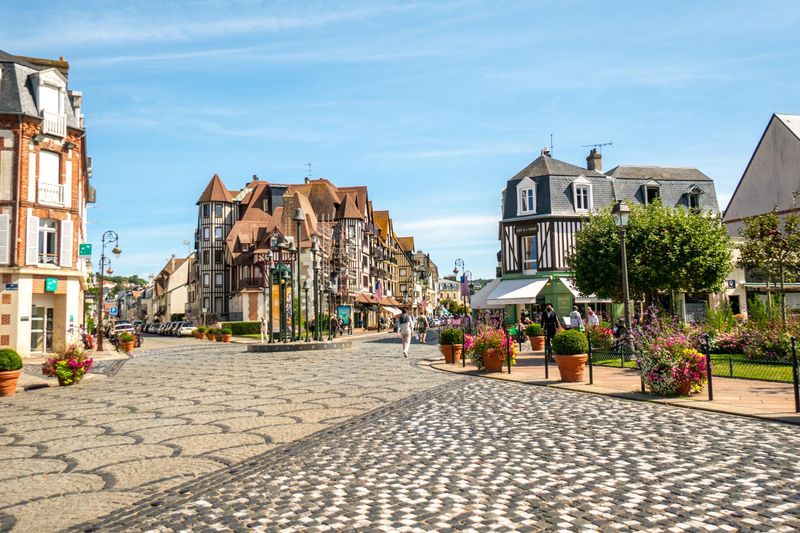
Deauville is famous for its sandy beaches, a long golden stretch with a classic boardwalk and neat rows of beach cabins. But Deauville is more than just a place to sunbathe. Often called the “Parisian Riviera,” it became a glamorous seaside resort in the 19th century when the Duke of Morny introduced horse racing, luxury hotels and a casino, turning the town into a byword for style and leisure.
That spirit is still alive today. The centre is full of designer boutiques, smart restaurants and pavement cafés where you can linger over seafood (Norman oysters are a must). Come in September and you’ll feel the buzz of the Deauville American Film Festival, the town fills with movie stars and cinema lovers, and you’ll notice plenty of American flags fluttering around the streets.
If you’re staying the night, Hôtel Barrière Le Normandy is the Deauville icon, a 1912 half-timbered grande dame beside the boardwalk. For a central, good-value base, Mercure Deauville Centre can be a great option.
Étretat
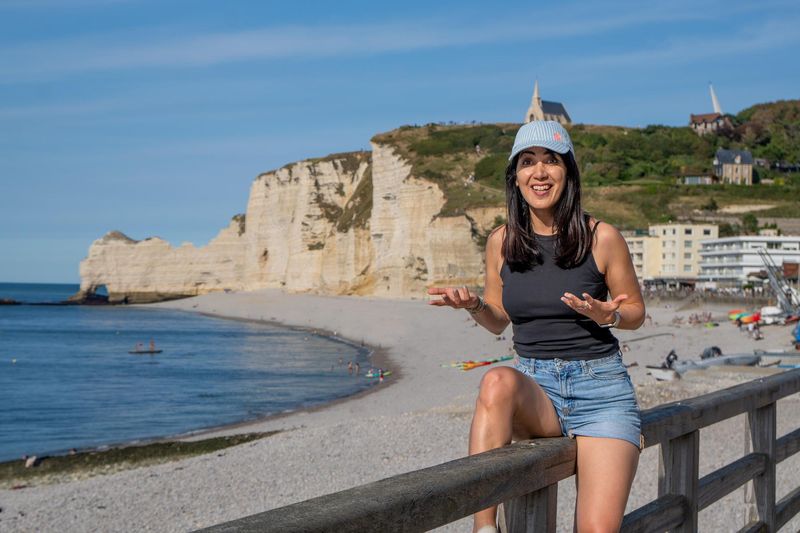
Among the most beautiful places to visit in Normandy, Étretat stands out for its dramatic arches and needle-like cliffs. Some say the main arch looks like an elephant dipping its trunk into the sea. It’s easy to see why 19th-century artists like Monet and writers like Maupassant were drawn here.
The best way to take it all in is to walk the cliff paths on either side of the beach for panoramas over the arches, the Channel and the town below. It can get very busy in peak season, so go early or aim for late afternoon when the light softens and the day-trippers thin out. Wear proper shoes; the paths are steep in places and can be slippery after rain. For staying overnight, the Dormy House on the clifftop with sweeping views over the bay, is a great choice.
Veules-les-Roses
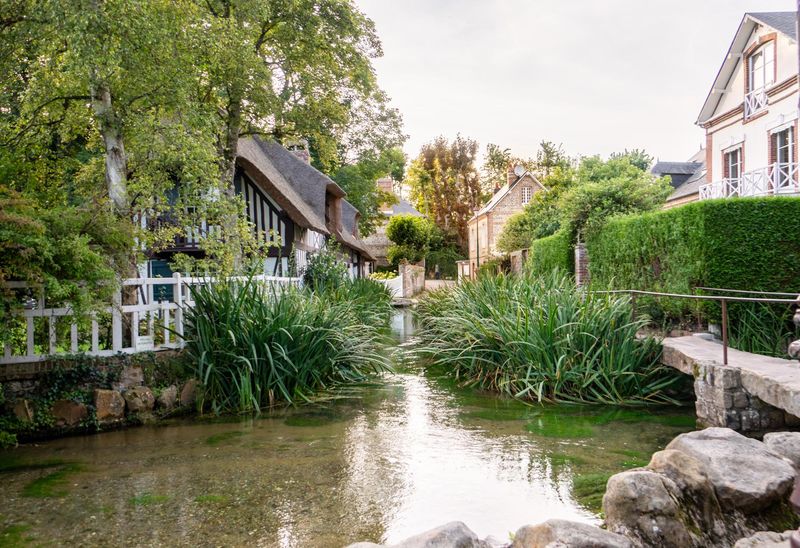
Veules-les-Roses is one of the most beautiful villages in Normandy. Not many tourists know about this village.
This village sits right on the coast, and what makes it special is that the shortest river in France flows through the village straight into the sea. Walking along its banks, you pass watermills, stone cottages, and colourful flower gardens.
The village has been here since medieval times, but it really flourished in the 19th century, when it became a seaside retreat for writers, artists, and Parisian society. Even Victor Hugo came here. The name “les Roses” comes from the rose gardens planted throughout the town
One of the best things to do here is simply to stroll through the village and follow the river to the beach.
Cabourg
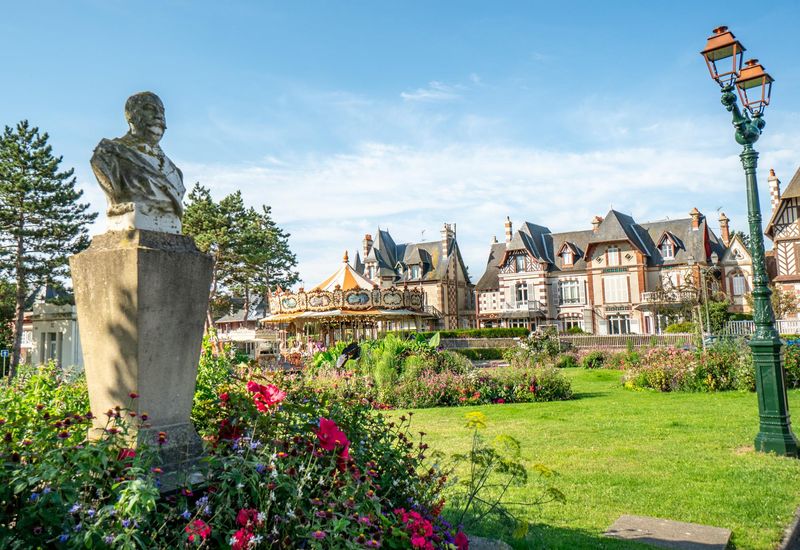
Cabourg is another charming seaside town in Normandy, known for its long sandy beach and elegant Belle Époque villas. The town grew in popularity in the 19th century as a fashionable resort, and much of that old-world charm can still be felt today.
We actually stayed here, since Cabourg is one of our favourite towns in Normandy. The seafront promenade is lined with cafés and restaurants, perfect for a leisurely walk or a sunset drink. One of the highlights is the Grand Hôtel Cabourg – MGallery, which has hosted famous guests for over a century. The French writer Marcel Proust spent his summers here, and the town is said to have inspired some of the settings in his famous novel In Search of Lost Time.
Cabourg has a lively yet relaxed atmosphere, with a wide sandy beach and plenty of space for swimming or just strolling along the promenade. Even outside the summer season, the town keeps its romantic charm.
Bayeux
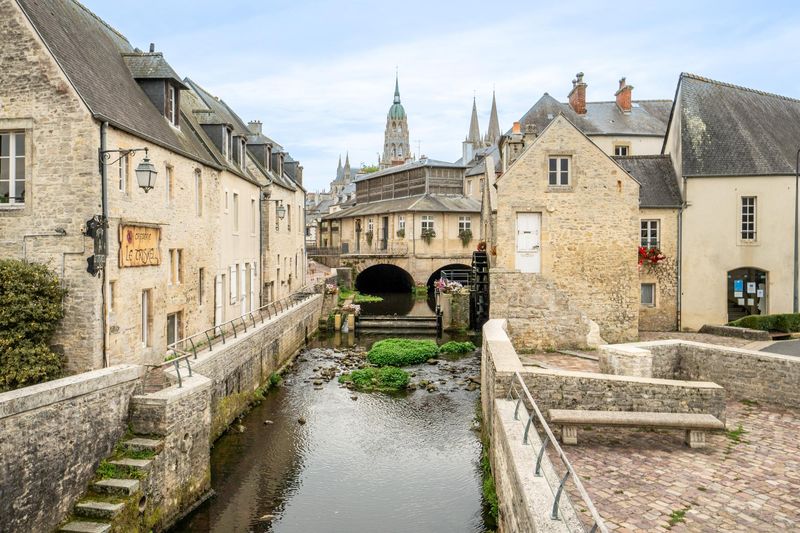
While much of Normandy was destroyed during World War II, Bayeux miraculously survived almost untouched. That’s why its historic centre is so beautifully preserved today, with cobbled streets, timber-framed houses and medieval landmarks at every turn.
The town’s greatest treasure is the Bayeux Tapestry, a 70-metre embroidery from the 11th century that tells the story of the Norman conquest of England and the Battle of Hastings. The Bayeux Cathedral, built around the same time, stands proudly in the heart of the old town and is a masterpiece of Norman Gothic architecture.
Bayeux also played an important role in more recent history — it was the first town liberated by the Allies after D-Day in 1944. Strolling through the centre, you’ll find small museums, traditional bakeries and plenty of cafés where you can pause and soak up the atmosphere. It’s compact, walkable and full of charm.
If you plan to spend the night, Villa Lara is one of the top boutique hotels in Normandy.
Caen
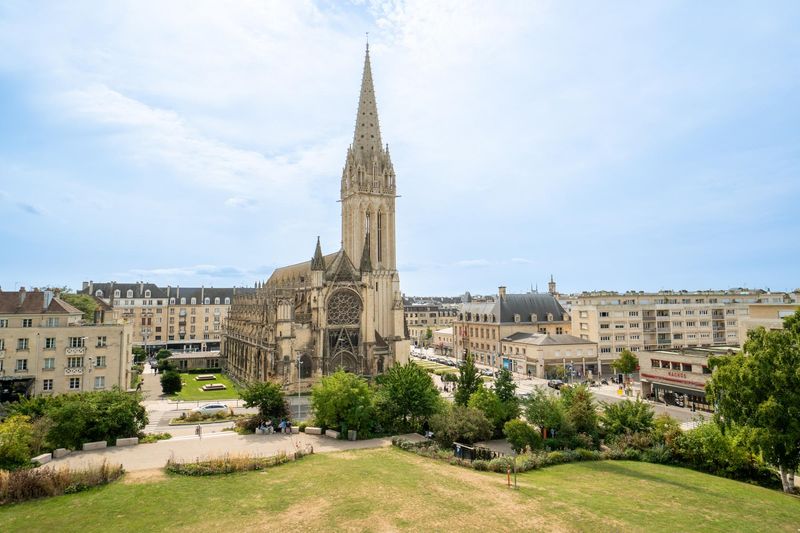
Caen is not really a town; it’s a city, but it’s worth adding to the list since it’s the closest stop if you arrive in Normandy by ferry from the UK. It’s a city rich in history, much of it tied to William the Conqueror, who made Caen one of his main residences.
The city’s main attraction is Caen Castle, one of the largest medieval fortresses in Europe, founded by William in the 11th century. You can walk along its ramparts for views over the city and visit the museums inside the walls. Caen is also home to two important abbeys built by William and his wife, Abbaye aux Hommes and Abbaye aux Dames, both remarkable examples of Norman Romanesque architecture.
Although much of Caen was destroyed during World War II, the city’s key monuments survived or were rebuilt, and today it blends old and new beautifully. It’s lively, walkable, and full of small cafés, local markets and students, giving it a friendly, youthful atmosphere.
If you plan to stay here, Best Western Plus Le Moderne is a great central option. For something more stylish, Ivan Vautier Hotel & Spa offers a fine-dining restaurant and modern design.
Mont Saint-Michel
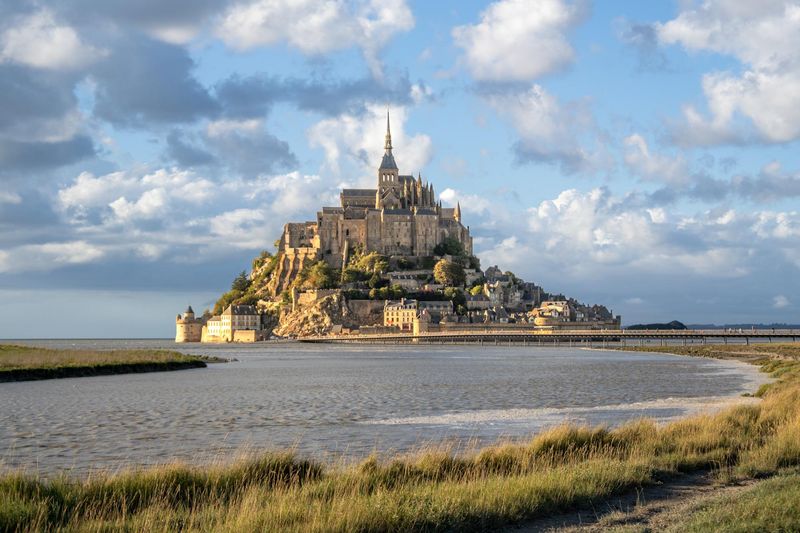
Last but not least, the famous Mont Saint-Michel, one of the most iconic places in France and a true masterpiece of medieval architecture. This tidal island, crowned by its abbey, rises dramatically from the bay and looks magical whether you see it at high tide, surrounded by water, or at low tide when the sands stretch out to the horizon.
The abbey was founded in the 8th century and over the centuries became both a place of pilgrimage and a fortress. Inside the walls, narrow cobbled streets wind their way up to the abbey, lined with little shops, cafés and viewpoints over the bay. It really does feel like stepping onto a medieval film set.
Mont Saint-Michel can be very busy, especially in summer, so it’s best to arrive early in the morning or stay overnight to enjoy it once the crowds have gone. Comfortable shoes are a must. It’s a steep climb, but reaching the abbey at the top is absolutely worth it.
If you’d like to stay close by, Auberge Saint-Pierre, a half-timbered 15th-century inn right on the island, is a beautiful and atmospheric option. For panoramic views from the mainland, Le Relais Saint-Michel offers rooms overlooking the bay.

